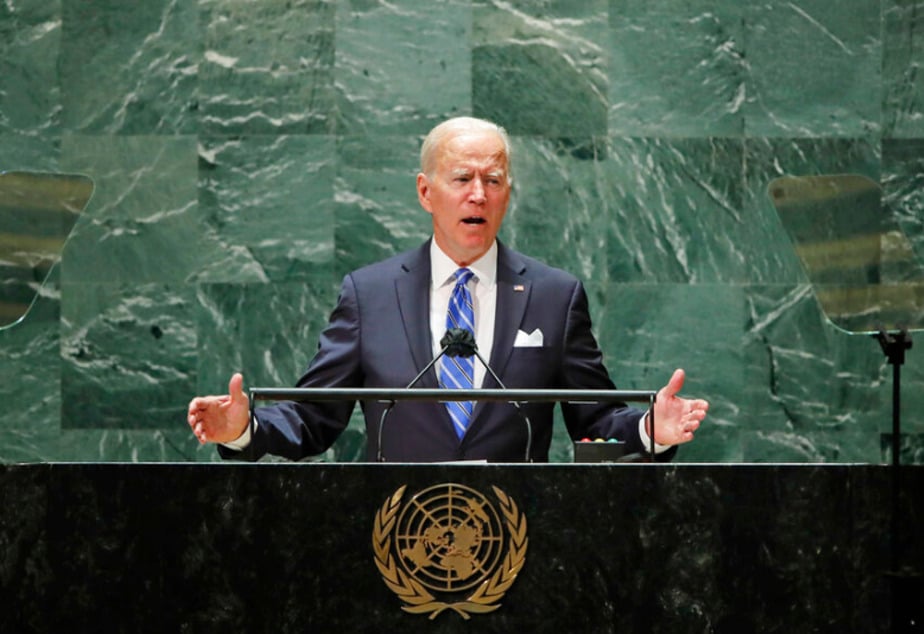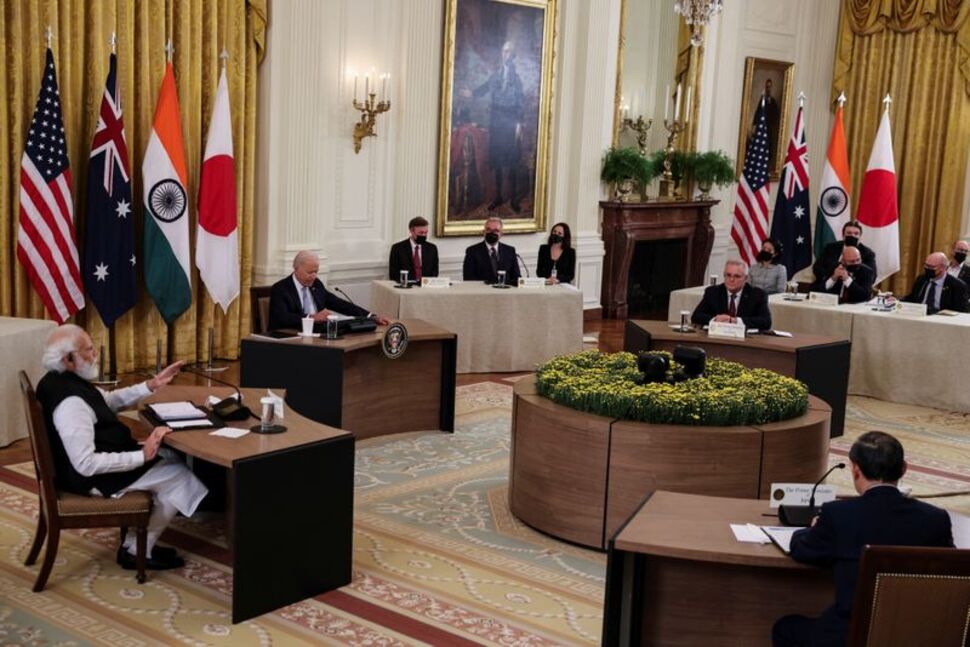
CREDIT: EDUARDO MUNOZ/POOL PHOTO VIA AP
U.S. President Joseph Biden’s debut speech at the seventy-sixth session of the UN General Assembly (UNGA) adamantly declared to the world that U.S. leadership is “back at the table in international forums.” Ushering the world into “a new era of relentless diplomacy,” President Biden firmly confirmed to the world that such leadership will seek neither a “new cold war” nor “world divided into rigid blocks” yet “oppose attempts by stronger countries to dominate weaker ones.” At this “inflection point” of leadership, the U.S. will continue to actively engage in both multilateral and minilateral institutions to defend democratic values and visions that are not only stamped into the nation’s DNA but also enshrined in the UN charter. Today, such values and visions, which have ensured “more than seven decades of relative peace and growing global prosperity,” face complex authoritarian challenges that “cannot be solved or even addressed through the force of arms.” Thus, the U.S. is determined to build a better future for the world by creating new multilateral security mechanisms to address urgent issues in global health and climate action.
With respect to global COVID response, in addition to re-engaging with World Trade Organization (WTO) and the COVID-19 Vaccines Global Access Facility (COVAX ) in continuing donations of lifesaving vaccines around the world, the U.S. proposes to exert multilateral efforts to establish a Global Health Threats Council, a global-level disease control tower overseeing concerted multilateral response toward future pandemic outbreaks. As for global climate action, the U.S. aims to be a leader in global public climate financing. Last April, in pursuant to the February declaration to rejoin the Paris agreement, the U.S. announced a new ambitious carbon emission reduction target (a new National Determined Contributions (NDCs) of 50–52% below 2005 levels by 2030) at the multilateral convention of the Leaders’ Summit on Climate. Since then, the U.S. has showed its intention to work closely with the private sector, G7 members and Congress to attain the goal of mobilizing $100 billion to put forward to the Build Back Better World agenda. The basic idea behind the agenda is to raise sustainable, transparent environmental and labor standards in low-income and middle-income countries’ infrastructure projects for the future and for the human rights of these countries’ citizens and workers. Such standards would allow the countries to better cope with the exacerbating climate crisis and to stay democratically resilient in “the new era of new technologies and possibilities that have the potential to release and reshape every aspect of human existence.” This November’s the twenty sixth UN Climate Change Conference of the Parties (COP26 ) in Glasgow, U.K. was highlighted in the speech as the next critical step in global climate action, of which President Biden expects every nation to bring their highest aspirations to attain the Paris Agreement goal of limiting global warming by 1.5 degrees Celsius.
Throughout the speech, President Biden prioritized revitalized diplomatic relationships with regional allies and partners over force of arms in facilitating the above multilateral engagement agendas. Starting with NATO , the U.S. will not only remain committed to Article 5 of the “sacred” alliance but work closely with the alliance in devising a new strategic concept to better respond to evolving threats. It was also emphasized that the U.S. will bolster diplomatic re-engagement with the European Union (EU) in tackling today’s imminent global challenges, as well as with the Association of Southeast Asian Nations (ASEAN) and the African Union and the Organization of American States, to improve the health and economic situations of the people living in these regions. What was most striking about the alliance revitalization agenda briefed in the speech was the elevation of the Quadrilateral Security Dialogue (or simply Quad) with India, Australia, and Japan. Quad, as the geostrategical foundation of the U.S.’ pivot into the Indo-Pacific, has been long perceived by many pundits simply as part of the Pacific nations’ China containment strategy. However, the expanded range of the partnership’s cooperative agendas beyond maritime security, as it was both mentioned in President Biden’s speech and discussed during last week’s first Quad meeting, demonstrates its augmented role in global and regional governance.

Credit: REUTERS/Evelyn Hockstein
First Quad Summit Reached Consensus for Open and Free Indo-Pacific
The Quad between the U.S., India, Australia and Japan had its kick-off summit at the White House on September 24 during the UNGA. The joint statement issued after the summit indicated that the four founding member states are committed to “promoting the free, open, rules-based order, rooted in international law and undaunted by coercion, to bolster security and prosperity in the Indo-Pacific and beyond.” In doing so, the member states are determined to “stand for the rule of law, freedom of navigation and overflight, peaceful resolution of disputes, democratic values, and territorial integrity of states” and to “work together and with a range of partners,” especially ASEAN and the EU. Throughout the summit, the member states discussed cooperative initiatives on a wide range of issues, from pressing global challenges like the global COVID response and climate change to emerging regional governance opportunities in new technology supply/value chain management, cybersecurity, space, etc. Quad members’ long-term endeavors to commit themselves to the partnership’s values were met with strong affirmation, especially in cooperative, shared-values-based management of supply/value chains for vaccine production, semiconductors and their essential components, and new technologies, such as clean-energy, clean-hydrogen, and green (decarbonized) shipping. Overall, the Quad summit was successful not only in aligning the member states’ long-term endeavors to contain China but also in strengthening U.S.-India relations and further revitalizing the partnership’s engagement with ASEAN and the EU.
Despite this success, the Quad faces future hurdles when it comes to U.S.-India relations and the partnership’s further extension. As U.S.-India relations increasingly become the crucial geostrategic key to resolving global and regional governance issues according to the auspice of U.S. interests, concerns are emerging over how the U.S. could placate India’s economic desire to nourish domestic industries in the context of India’s Act East policy while constraining India’s security ties with Russia. In addition to these bilateral relations, the ongoing controversy over the minilateral institution’s further extension is another hurdle. Some argue against further extension of the Quad on the grounds that it might complicate agenda-setting processes and reduce member states’ political flexibility, resorting to the Quad’s networked engagement with new separate coalitions as a more effective alternative to its extension. In contrast, others call for further pluralization of the Quad into “the Quad Plus” to strengthen regional security and governance cooperation between the Quad and non-Quad nations based on the premise that the very act of strengthening regional cooperation itself incentivizes Quad countries to cooperate.